Ten thousand stars bedazzle the eye on a dark night. Wait, how many stars in the sky?
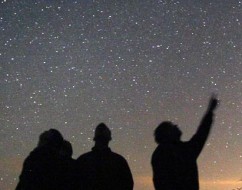
Bob King
Go out on a dark night and you'd swear there are thousands of stars in the sky. Too many to count. 10,000 at least. But why guess when someone has already done the counting for you? Astronomer Dorrit Hoffleit of Yale University, well known for her work with variable stars, compiled the Yale Bright Star Catalog decades ago. It tabulates every star visible from Earth to magnitude 6.5, the naked eye limit for most of humanity.
You might be in for a surprise when you read it, though. To answer the question, "How many stars in the sky?" The total comes to 9,096 stars visible across the entire sky. Both hemispheres. Since we can only see half the celestial sphere at any moment, we necessarily divide that number by two to arrive at 4,548 stars (give or take depending on the season). And that's from the darkest sky you can imagine. I don't know about you, but that number seems paltry to one's impression of an inky night in the backcountry.
At the poles, where the north and south polestars are pinned to the zenith and no stars rise or set, the same ~4,500 stars are visible every single clear night of the year. At northern mid-latitudes, the pole star is halfway up in the northern sky, allowing us to peer deeper into the southern realms of the celestial sphere. During the course of a year from latitude 45° north, we see roughly half again as many stars as we do at a particular time on a given evening. That tallies up to approximately 6,800 stars. Still pretty lean, but apparently enough to convey the impression of an intensely starry sky.
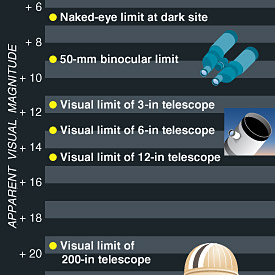
Sky and Telescope
Astronomers use the magnitude scale to measure star and planet brightness. Each magnitude is 2.5 times brighter than the one below it. Altair, in Aquila the Eagle, shines at about magnitude +1 which is 2.5 times brighter than a 2nd magnitude star, which is 2.5 times brighter than a 3rd magnitude star, and so on.
A first magnitude star is 2.5 x 2.5 x 2.5 x 2.5 x 2.5 (about 100) times brighter than a 6th magnitude star.
The bigger the magnitude number, the fainter the star. If an object is really bright, it’s assigned a negative magnitude. Sirius, the brightest star sparkles at magnitude –1.4, Jupiter at –2.5, and Venus tops the planets at –4.4. The Full Moon reaches a magnificent –12.7, bested only by the Sun at –26.7.
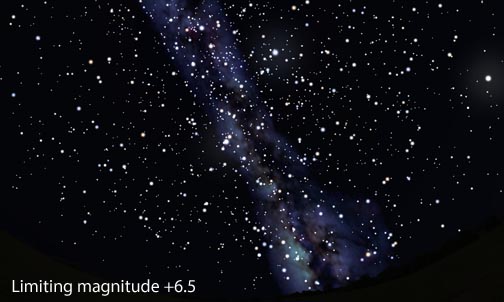
Source: Stellarium
While the total number of naked eye stars may seem unimpressive, consider what happens to the sky in and around cities, where most of us live. From the suburbs, the magnitude limit is around +4 for a worldwide total of about 900 stars or half that for your location. If we set the city limit at magnitude +2 (stars similar to the Big Dipper in brightness) we're left with just 70 stars worldwide, or 35 stars visible from say, downtown Chicago or Boston.
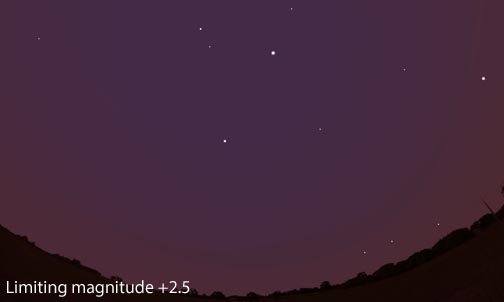
Source: Stellarium
No wonder city dwellers are stunned by the night sky when they take their first trip to the country. Stars barely exist for those trapped beneath an ever-present dome of light pollution.
Numbers increase exponentially if we go in the opposite direction as there are far more faint stars than bright. The standard limit for a pair of 50-mm binoculars is 9th magnitude, opening up a vista of some 217,000 stars across the heavens. Impressed? A 3-inch telescope pulls in a treasure-worthy 5.3 million, enough for several lifetimes of viewing pleasure. Dare I go further?
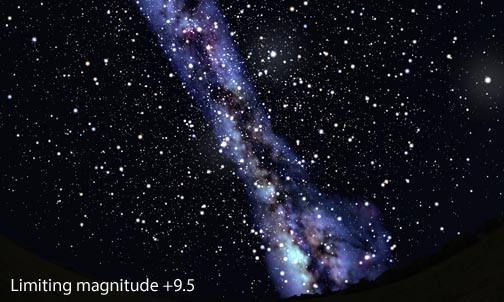
Source: Stellarium
On the very best nights, I can reach 16th magnitude with my 15-inch telescope, or 380 million stars. Well, only half that really, but who's counting?
How many stars in the sky can you see with binoculars? Use Gary Seronik's Binocular Highlights to help you find out!
 17
17








Comments
Anthony Barreiro
September 17, 2014 at 1:10 pm
Thanks Bob. Even in a light-polluted city, binoculars will help you see a lot more stars than you can see with just your eyes. While a telescope will show you fainter stars than you can see through binoculars, binoculars' wide field of view and ability to sweep easily across the sky provide a more relaxed skywatching experience. I live in a city and often spend time in the back yard with binoculars.
You must be logged in to post a comment.
Frank Reed
September 17, 2014 at 4:34 pm
Anthony, that's a great point. Also the limiting magnitude in a big city can be lower than described here. I lived on the north side of Chicago for many years, and on clear nights I could see down to about magnitude 3.0. Of course, if you stand right next to a street light, well, not so good. Immediate, local light pollution is easily avoided but we forget to advise folks to do that. Walk to a darker spot. And equally important, even in cities, you have to give yourself a chance to dark adapt. If you step outside from a brightly-lit room, you won't see many stars, even if you live in the country. This is a major issue in suburban areas. If you want to see stars, find a dark spot and wait at least 15 minutes.
You must be logged in to post a comment.
Anthony Barreiro
September 17, 2014 at 6:36 pm
My home town of San Francisco, California has a lot of hills, and many hilltops happen to be parks. Getting to the top of a hill above most of the streetlights significantly improves the darkness of the sky, at least toward the zenith. The horizon in all directions is still overwhelmed by light pollution.
You must be logged in to post a comment.
Justin S
September 17, 2014 at 1:57 pm
So why do we get the impression that there are many more? Millions even? I postulate it is because our mind notes that there are more faint stars than bright ones. The logical conclusion is that there are vastly many more that we can’t see because they are too faint. Even some ancients guessed that the “milky way” was made up of the light of stars too faint to see individually.
You must be logged in to post a comment.
Frank Reed
September 17, 2014 at 4:47 pm
There has been an odd explosion in the accounting on naked eye stars in the past ten or twenty years. It used to be standard to say that there are about 6000 naked eye stars all across the celestial sphere. This was based on a "normal" limiting magnitude of 6.0. More recently, some sources have gotten carried away with the possibility that the "real" limiting magnitude for human vision is around magnitude 8.0, and that implies five times as many naked eye stars. Since the total number ramps up so sharply with a small change in limiting magnitude, there's no real hard answer on this one.
You must be logged in to post a comment.
Dan-Duriscoe
September 18, 2014 at 1:22 am
The actual number of naked eye stars at a given site also depends on the atmospheric extinction and (for dark sites) the brightness of the natural airglow, both of which are significant factors below about 30 degrees above the horizon. While most people wouldn't think of looking for faint stars in this region, one half of the area of the hemisphere of the sky is below the 30 degree line. Even in a sky with no artificial sky glow, the number can go down drastically in hazy conditions or on bright airglow nights. The absolute best that is theoretically possible (on a 9000 foot mountain top where the air is free of dust and under very low airglow skies) is about 5,500 stars, if you can see 7.2 at the zenith.
You must be logged in to post a comment.
Gordon
September 19, 2014 at 12:27 am
I wonder how many of these are doubles where you would only see them as one.
You must be logged in to post a comment.
David Fried
September 19, 2014 at 2:49 pm
Bob, don't your calculations assume that the 9,056 stars are evenly distributed through both hemispheres? Are they, or does the Southern Hemisphere maintain its usual advantage here too?
Further to Frank Reed's point--I'm 63, with astigmatism and yellowing corneas, and I think that as a practical matter I can't get past mag. 5.5 or so in the darkest sky. 6.5 is a fantasy. I live in Boston proper and most nights I would peg the limiting magnitude in my backyard at 2.5 or so.
You must be logged in to post a comment.
Antonio Mario
September 19, 2014 at 6:08 pm
Bob,
Thanks for posting a very interesting article.
Allow me picky here, if I may. On the two paragraphs explaining the magnitude scale, since the difference in magnitudes of two stars (m1 and m2, say) is actually m1 - m2 = -2.5*log(B1/B2), a +1 mag (i.e., first mag) star is actually *approx.* 2.512 (*NOT* 2.5) brighter than a 2nd mag star, and so forth (i.e., B1 ~ 2.512 * B2).
Using that difference equation above one also finds that a 1st mag star is EXACTLY 100 times brighter that a 6th mag star.
Again, thanks for a very informative article.
You must be logged in to post a comment.
Jim-Baughman
September 19, 2014 at 6:45 pm
This article mentions "north and south polestars"... Is there a south polestar? If so it's news to me.
You must be logged in to post a comment.
Geoff-Smith
September 19, 2014 at 9:29 pm
There is a southern pole star--sigma octantis, but it's magnitude 5.4, so very hard to see unless you have a dark site and know exactly where it is.
You must be logged in to post a comment.
Peter Wilson
September 20, 2014 at 10:27 am
No polecats in the south, either.
You must be logged in to post a comment.
Francis
September 20, 2014 at 4:35 am
Again a bit of pickiness. Sorry about that!
You divided the total number 9096 equally into 2 hemispheres. David Fried already pointed out that such equal distribution is unlikely. But you also say that if you're at mid latitudes you can see some of the other hemisphere. True, but you lose part of your own. I know that careful reading yields that this 6800 is over the course of the year, but your "... impression of an intensely starry sky." implies that the 6800 is instantaneous.
From the Earth's surface, you can never see more than a half of the celestial sphere (a hemisphere) at any one time. So I'm afraid the number remains at 4000 to 5000 (assuming reasonably even distribution). Note that I'm ignoring that if you're up a mountain the horizon is slightly below the horizontal plane, as well as atmospheric refraction which has a similar end-result.
You must be logged in to post a comment.
froy
September 20, 2014 at 11:40 am
Great article.
But where did 6.5 come from?
Myself I've seen much fainter than mag 6.5 that under an SQM night sky of 21.90.
Does that mean there could be closer 20,000 stars over the whole sky?
Or closer to 10,000 stars at any one time.
Cheers - Frank
You must be logged in to post a comment.
September 21, 2014 at 2:18 pm
It is mind boggling to think that there are estimated to be 300 billion stars just in our Milky Way home galaxy and that the author says he can see about 380 million with his 15 inch telescope - just about 1/1000 of that total!
You must be logged in to post a comment.
EdSay1
July 18, 2022 at 6:36 pm
In Genesis, Yahweh says to Abraham "I will surely bless you and make your descendants as numerous as the stars in the sky." There are currently approximately 14 million Jews worldwide. So, the writer overestimated the number of stars visible to Abraham by about 13,000,991. That's a pretty big whiff. Now a days most of us don't take the Old Testament literally. So will give the writer a pass. And after all it is a nice piece of prose.
You must be logged in to post a comment.
Bob KingPost Author
July 18, 2022 at 7:45 pm
EdSay,
I could say that skies were darker in the days of Abraham, so more stars would be visible. Or that Yahweh was keenly aware of the true number of stars in the universe. But I like your take the best — to enjoy it as a nice piece of prose. Thanks for your comment.
You must be logged in to post a comment.
You must be logged in to post a comment.